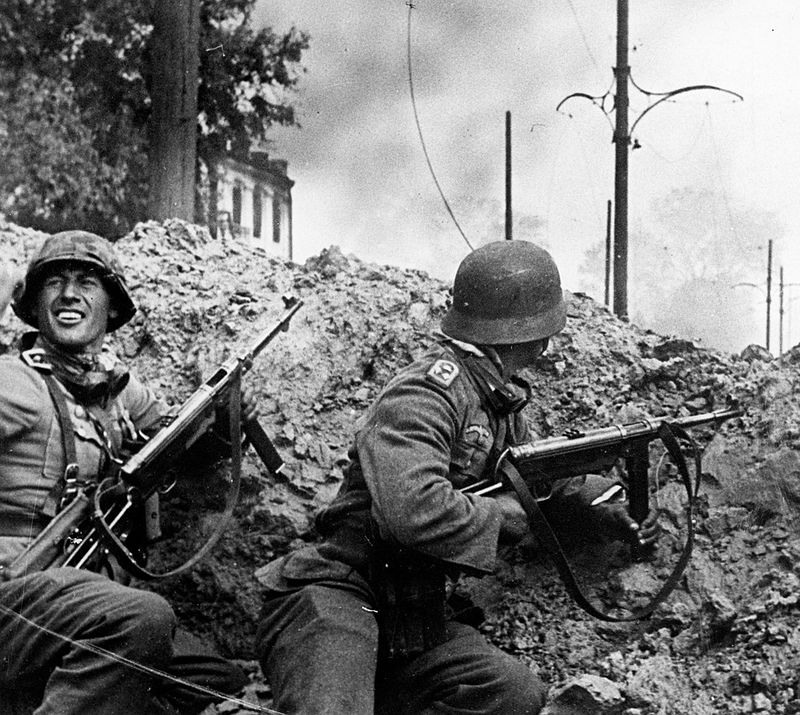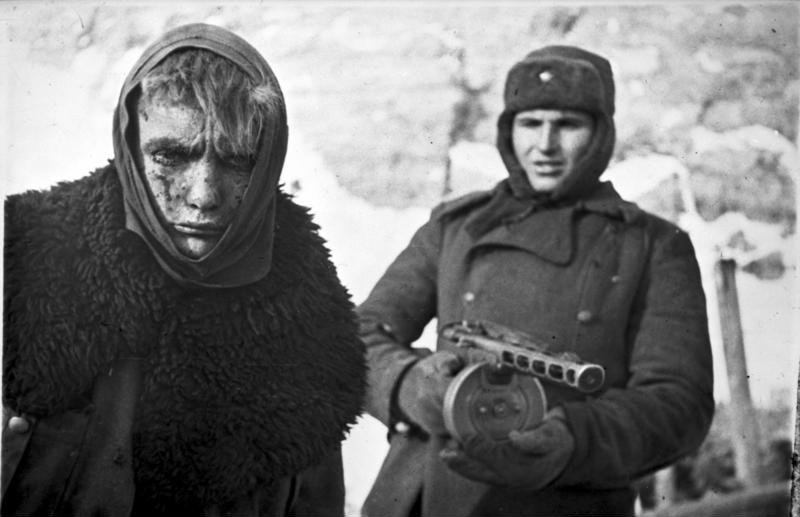
In the summer of 1941 the German army kicked off Operation Barbarossa, the long-awaited invasion of the Soviet Union. Army units of the Wehrmacht (German Army) as well as troops from friendly Axis nations like Romania and Hungary made massive progress during the warmer months, steamrolling the unprepared Russians and shooting up villages during their advance. By the fall, the Axis advance slowed as Panzers (tanks) ran low on fuel and started breaking down. But during the 1941-42 winter, Hitler’s forces held their ground; and by the following summer, the Axis were winning fights everywhere from the Mediterranean to the Pacific. As the snow thawed and Hitler’s optimism grew, German Army Groups B and Don prepared for a full-on assault on present-day Volgograd, an industrial town situated on the Volga river and named for Soviet leader Joseph Stalin. The Battle of Stalingrad was to be a crushing symbolic victory.
ASAP: Hitler and Stalin’s egoes came into conflict over Stalingrad; the ensuing urban battles reduced the city to ruins and turned the tide of the war.
Read on for details!

In July, as the German Luftwaffe (air force) began bombing raids on Stalingrad, Soviet command quickly moved 2 army groups to positions north of the city. The Kotluban Operations, as they were known, managed to slow the German advance despite costing 200,000 Red Army troops. By August 3rd, the Wehrmacht had advanced so far into Stalingrad that General Vasily Chuikov – commander of the Soviet 62nd Army – only controlled a thin strip of land on the banks of the Volga River. The Wehrmacht had reduced much of Stalingrad to rubble by this point, and the situation for Chuikov’s men (and civilians hiding amongst the rubble) looked hopeless. Urban combat in the city became so intense that, for example, nearly 2,000 men from both sides were killed fighting over one building – Pavlov’s House, a small residential building. As Germans and Russians lost their minds with fear and exhaustion, officers on both sides were ordered to shoot their own men if they tried to desert.

But Stalin, sensing the importance of the battle, channelled huge amounts of men and supplies into the fight by train and on foot. Just as the Soviet position was improving, the German situation was becoming more desperate. They held most of Stalingrad – but there weren’t many reinforcements coming, and much less food. By November 19th, Soviet forces had begun Operation Uranus – a massive flanking manoeuvre that completely encircled the starving, freezing Axis troops. Up to that point, the Wehrmacht had advanced quickly by using Kesselschlacht (or “kettle battles”) tactics – surrounding enemy positions and starving them out. By November 23rd, the Soviet net had closed and the entire German 6th Army was surrounded in its very own Kesselschlacht.

Hitler refused to help his troops at Stalingrad, and forbade them from retreating. Slowly, Soviet troops regained strength and pushed the Wehrmacht out of the ruined buildings of Stalingrad, throwing grenades every 25 metres and killing enemy soldiers with sniper fire. 6th Army soldiers were so worn out and cold that many of them died in their sleep. On February 2nd, 1942, Field Marshal Friedrich Paulus – commander of the encircled 6th Army – surrendered alongside his surviving soldiers.

By some counts, nearly 2 million people – Germans, their allies, Red Army, and Russian civilians – were killed at Stalingrad. It was the largest engagement of the largest war in human history; it was also its turning point. From February of 1943 onwards, Allied forces began winning more battles and regaining more ground from the Axis. Stalingrad caused such unprecedented levels of human suffering because of the stubbornness and viciousness of two men: Adolf Hitler and Joseph Stalin. Hitler’s refusal to allow his armies to retreat, and his insistence on pushing so far into the USSR coupled with Stalin’s callous disregard for Russians’ lives is a terrifying example of the violence that can occur when men are given power that they are not worthy of.
Main Points
In a hurry? Here are the ASAP notes on this topic.
- Who? Hitler’s Wehrmacht and friends from Romania, Hungary, Italy, and Croatia; they attacked the Soviet Red Army in Russia. By the Soviet counter-offensive in November 1942, Axis forces numbered 1.04 million and Soviet defenders about 1.4 million.
- Where? Stalingrad, a Russian city on the Volga River – deep in Soviet territory – and surrounding countryside.
- When? Beginning in the summer of 1942, the Battle of Stalingrad dragged for on 5 months until the 6th Army’s surrender in February of 1943.
- What? The battle dragged on for over 5 months and saw some of the most vicious urban combat in human history. Stalingrad was reduced to rubble and both sides ran their soldiers into the ground with limited food or supplies. After the Soviets received significant reinforcements in November 1942, they managed to trap the German 6th Army and essentially starve them out.
- Why? Hitler, a notoriously over-confident person, set his sights on Stalingrad because it bore the name of his enemy, Uncle Joseph Stalin. The USSR’s leader defended the city for the same reason – its loss would have been symbolically terrible.
- Result: German Field Marshal Paulus surrendered on February 2nd 1943, signalling a turning point in WWII. It was Germany’s first major loss. To quote one German soldier: “there are two people who don’t know Russia gets cold in the winter: Napoleon Bonaparte, and [Hitler].”
Food for Thought
Like what you’ve read? Here are a couple essay questions/prompts to get you thinking. Good writing is all about answering questions the reader didn’t know they had, after all. These questions are to inspire further research, help with an academic paper, or maybe just get you thinking more about the topic.
- Why did the Wehrmacht treat the Red Army so poorly? Did race and ethnicity play a part? Compare German treatment of French, English and American prisoners of war (and civilians) to their treatment of Slavic people.
- Would the Battle of Stalingrad gone differently had the Third Reich and the USSR been led by sane people?
- Examine the cultural impact of Stalingrad on Russian propaganda.
- Urban combat at Stalingrad was some of the most intense the world had ever seen. What were some of the lessons learned by both sides that are still taught by militaries today?
- What was the impact of the battle on Stalingrad’s civilian population?
Further Reading & Citations
Here are a couple useful sources for further reading or using to flesh out an essay. Remember to cite everything properly!
- Beevor, Antony. Stalingrad: The Fateful Siege, 1942-1943. New York: Viking Press, 1998.
- Morina, Christina. Legacies of Stalingrad: Remembering the Eastern Front in Germany since 1945. Cambridge: Cambridge University Press, 2011.
- Frederic F. Clairmont. Stalingrad: Hitler’s Nemesis. Economic and Political Weekly 38, no. 27 (2003): 2819-823.
- Hellbeck, Jochen, Christopher Tauchen, and Dominic Bonfiglio. 2015. Stalingrad: the city that defeated the Third Reich.
- Grossman, Vasiliĭ, Robert Chandler, Yury Bit-Yunan, and Elizabeth Chandler. 2019. Stalingrad.
3 main mistakes by the Germans – 1. they should not have invaded Soviet until they have secured Northern Africa and invaded Great Britain 2. Divert the forces to capture Soviet’s oilfields to Stalingrad just because of the name 3. Over confidence of battling multiple fronts at the same time
LikeLike
Definitely! A classic example of over-confident and under-qualified leadership. Thanks for your input!
LikeLike